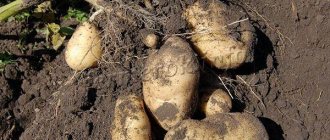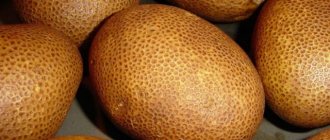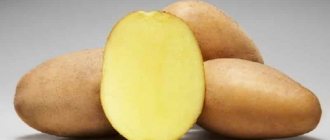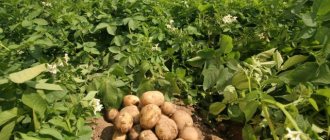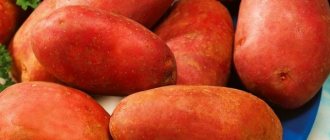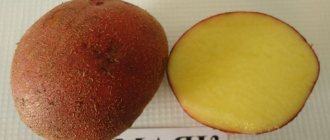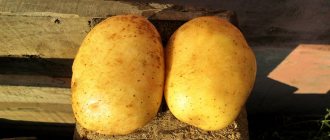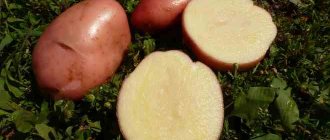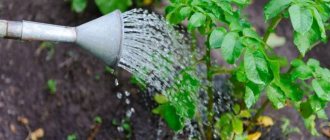Description of the Belarusian potato variety Vector
Belarusians consider potatoes their national product, their second bread. 70% of the diet comes from this crop. Potatoes contain a wide range of useful vitamins and microelements, saturate the body with potassium, iron, magnesium, and zinc. Many favorite dishes are prepared from potatoes.
Breeders are constantly working to develop new varieties that are resistant to diseases and pests, and improve their taste and adaptability in different climatic zones. By crossing existing potato varieties and improving their qualities, Belarusians developed a new variety of root crop called Vector.
What does the Vector variety of potatoes look like?
Characteristics of the Vector variety
The variety is successfully grown in the Central and Northwestern regions of Russia. It easily adapts to climate and soil. A medium-sized bush 30-45 cm high has dark green small leaves with clear corrugation and blooms with purple flowers. Gives high yield; from one bush you can collect 14 or more tubers weighing up to 120 g each. This is a mid-season variety and usually matures 15 weeks after planting.
The tubers are oval-shaped, pink in color, with yellowish flesh and brown skin. They cook well without losing their color. The plant tolerates weather conditions well: heat, strong wind. It does not require special soil; it can be planted in any home or garden area. It is resistant to many viral diseases.
Important! Diabetics should be careful with this vegetable. A large amount of zinc, starch, and polysaccharides increases the sugar level in the patient’s blood. The permissible consumption rate is no more than 200 g per day.
Potato flowers bloom in purple inflorescences
Features of the variety
Vector potatoes are medium-late, the period from planting to the formation of root crops is on average 110 days. Productivity varies between 250-540 c/ha.
Under favorable weather conditions, it can reach 670 c/ha. The level of marketability is very high - on average 95%. During storage, the volume of waste is usually less than 5%.
Bush
The bushes of this variety are straight, low, but do not tolerate excessive density. The leaves are small and dark green.
The flowers are large and purple in color. From 10 to 15 inflorescences usually grow on one bush.
Tubers
The root vegetables are medium in size and round or oval in shape, with small eyes. The average weight of one potato is 120 g. The skin of the tubers is dense, brown with a red tint.
The pulp is firm, but juicy, light yellow in color. One root vegetable contains up to 20% starch. During heat treatment, the pulp does not darken. Nitrates are absorbed in very small doses.
Advantages and disadvantages of the variety
Vector potatoes are a relatively young variety, but have already gained popularity among the people. Consumers appreciated its good aspects:
- excellent taste;
- high productivity;
- the firm, juicy flesh of table potatoes does not darken when cooked;
- ease of transportation;
- long shelf life (only 5% of root vegetables spoil during winter storage);
- resistance to diseases such as late blight, scab, cancer pathogens, viral infections, alternaria;
- good adaptability to negative climatic conditions (heat, wind, drought);
- unpretentiousness to growing conditions;
- versatility of use;
- suitability for mechanical cleaning.
Disadvantages include:
- long ripening period;
- friability during cooking;
- instability to wrinkled mosaic, golden nematode;
- high starch content.
Note! Friability during heat treatment and starch content within 20% can be considered both pros and cons. It depends on what to cook from this vegetable.
You can cook anything from these potatoes.
Pests and diseases
Breeders, creating the Belarusian Vector, took care of immunity. The crop rarely suffers from: potato cancer and nematode, fusarium rot and anthracnose.
Important! The variety is practically not susceptible to viral diseases.
But Alternaria, late blight, and common scab can destroy the crop if measures are not taken.
Among the pests, gardeners note the Colorado potato beetle, wireworm, mole cricket and slugs. Insecticides are used for control.
The larvae of the Colorado potato beetle and slugs will have to be removed manually, and traps will have to be placed on the mole cricket
Rules for caring for the variety
Until the first shoots appear, the crop does not need watering. When planting, the soil contains enough moisture. Early watering can trigger the development of roots located in the surface layer of soil, which will constantly need additional moisture. It is advisable to carry out the first watering no earlier than a month after planting.
Although this type of potato is drought-resistant, the soil should not be allowed to crack. Before flowering, it is enough to water the bushes once every 10 days. With the formation of the first flowers, watering should be increased to 2 liters of water per bush 2-3 times a week. The water is heated in the sun before watering.
Features of agricultural technology
Growing the variety does not cause much trouble for the gardener. However, to obtain a large number of tubers, you need to consider several recommendations:
- for planting, choose potatoes that are undamaged, smooth, and medium-sized;
- high-quality seed material has sprouts more than 2 cm long;
- the soil temperature at the time of planting root crops should be more than 10 degrees;
- the optimal immersion depth for tubers is 10 cm;
- the minimum number of waterings of potatoes during the period of crop formation is 4;
- bushes need to be provided with 3 feedings: 1 - before the formation of buds, 2 - during the active formation of flowers, 3 - during the flowering process.
Advice. To improve yields, it is necessary to avoid thickening of bushes. The distance between them should be at least 30 cm, the rows are located 70 cm from each other.
Diseases and pests
The Vector potato variety is immune to many diseases. Thickened plantings, non-compliance with planting patterns, and excessive watering can create conditions for rot. Potato plantings are also susceptible to late blight. Mycelia of a fungal disease can be found in seed material, soil, or the remains of previous crops affected by this disease. To prevent late blight disease, you need to carefully check the planting material, choose a sunny, well-ventilated place for planting, maintain the distance between the bushes, and drain the soil.
The main pests of potatoes are the Colorado potato beetle, leafhoppers, potato nematodes, potato moth, wireworms, potato flea beetle, potato cutworm. Insecticides help against them.
Leaves affected by late blight
Farmer reviews
Despite the youth of the variety, Vector potatoes have already won the hearts of many gardeners .
Vadim, Voronezh : “Vector potatoes have been growing on my farm for three years now.
The yield is excellent, mechanization for harvesting works well. Tubers are almost not injured. After three years of cultivation, even the Colorado potato beetle could not defeat it. Good variety! Victor, Mogilev : “We grow vector on an industrial scale in the field for sale. We recycle it for starch. We leave some for ourselves. Yellow flesh, good potato taste, except that it boils a little more than we would like.”
Ivan Konstantinovich, Ryazan region : “I grow the variety in the field for sale. The yield is high, and the marketable yield is also excellent. I have zero problems with parasites; I learned to fight them before they appeared. Transporting Vector is easy; tubers are not damaged during long-term transportation. I’ve been growing it for more than 5 years, so I can give you an assessment. The market sells out quickly.”
How to harvest and store crops
Potatoes are collected in sunny weather, dried well, cleared of soil, sorted, and placed in boxes prepared in advance. Only healthy, undamaged tubers are selected for storage.
Frozen, injured, rotting tubers cannot be stored. Their preservation will also negatively affect high-quality root crops stored for storage.
Note! This type of nightshade can be kept in storage separately from other vegetables, or together with beets. Beets placed on top of the tubers will prevent the potatoes from rotting. It will absorb excess moisture in the room.
It is better to store crops in boxes
The Vector variety has good keeping quality. If the storage room is maintained at a certain temperature and humidity and is equipped with ventilation, then the crop will easily be preserved until spring, until the next harvest. Thus, there will always be dishes with delicious boiled potatoes on the table.
Correct fit
Selecting tubers is a responsible procedure. The size, quality and condition of the tuber directly determine what the future harvest will be. For some reason, many people believe that small potatoes can grow into large root crops. This is a deep misconception. In order for the harvest to be not just good, but excellent, it is necessary to select planting material according to the following criteria:
- Potatoes should be no smaller than a chicken egg.
- Their surface should be free of any defects: fungal manifestations, cuts, stains, etc.
- Potatoes with the largest number of eyes are selected.
When the planting material is selected, it needs to be prepared for further work. Selected root vegetables are placed in boxes and germinated. To make the crop sprout faster, it is covered with sawdust and watered with water at room temperature.
A few days before planting, the tubers are warmed up. To do this, they are transferred from the storage place to the street, into the sun.
When the material is ready, planting is carried out. The garden must first be fertilized.
Standard landing pattern:
- Between holes – 25-30 cm.
- Between rows - about 70 cm.
Planting depth is up to 15 cm. If grown in the south - the depth is no more than 10 cm, if in the north - up to 15 cm.
Regarding feeding
To prepare the fertilizer, dilute 1 liter of chicken manure in 10 liters of water and add 1 tbsp to the mixture. l. urea. Each bush will require 0.5 liters of fertilizer. They apply the feed directly under the bush.
If it is found that the plant is developing slowly, the stems are lagging in size and have insufficient thickness, and the leaves have begun to turn yellow, it is necessary to fertilize in several stages:
- Before flowering begins. During this period, urea is added (1 tablespoon per 10 liters of water).
- During the appearance of buds. This time potassium fertilizer is applied (1 tablespoon of potassium is diluted in 10 liters of water).
- During the flowering period. Superphosphate will be used as a top dressing (1 tbsp per 10 liters of water).
After passing through three stages, the bush is watered again.
Features of cultivation
If you follow all the rules for caring for potatoes, you can be very pleased with the yield. You need to pay attention to the selection of tubers for planting. Choose a medium size, regular round shape and with many eyes. It is necessary to ensure that all tubers are healthy and not damaged by pests. Such planting material has a high probability of producing strong shoots.
May be interesting Potatoes Black potatoes: description and characteristics, reviews Impala potato variety - all the pros and cons Liley potato variety: description and characteristics, reviews
The most favorable time for planting Vector is the end of May. The ripening of the harvest can only be expected in the fall. There are ways to speed up the growth of bushes. For this:
- place the selected planting material in dry boxes;
- wait about a week until sprouts appear from the eyes;
- after that you can send them for landing.
For effective growth of bushes, it is necessary to prepare the ground. Clear future beds of litter and other grass. For better cultivation, pay attention to the soil; it should be loamy, slightly acidic, or at least neutral. Black soil and sandy loam are suitable. Using soil prepared in the fall will improve the conditions for the development of sprouts. Dig holes at a distance of 15 centimeters and a depth of at least ten. Before placing the selected material in the holes, fertilize them.
Landing rules:
- Tubers must be placed in the holes with their sprouts facing up.
- Cover them with earth.
- Pour in a liter of water.
If the planting technology has not been disrupted, then the sprouts should appear simultaneously. During the initial two to three weeks, the most important thing is to allow the vegetables to properly develop the above-ground part of the sprouts. To do this, you need land constantly:
- weed;
- loosen;
- moisturize.
There is no need to constantly water the bushes, right up until the first flowers appear. Only after this the roots need constant moisture and feeding.
Already with the first hilling, you can carry out the first fertilizing. It's very easy to prepare. Add one tablespoon of urea to a ten-liter bucket. Then water each bush with the prepared solution, half a liter per plant. It is not necessary to feed the crop if the tubers are planted on fertilized soil.
